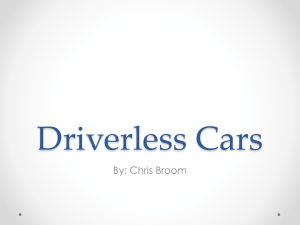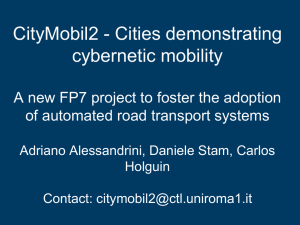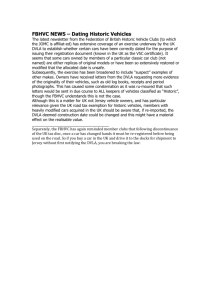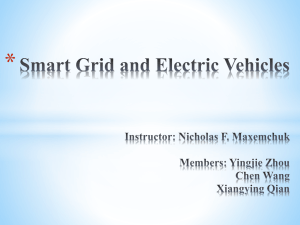Vehicle-To-Vehicle Communication in Driverless Cars via Wireless
advertisement
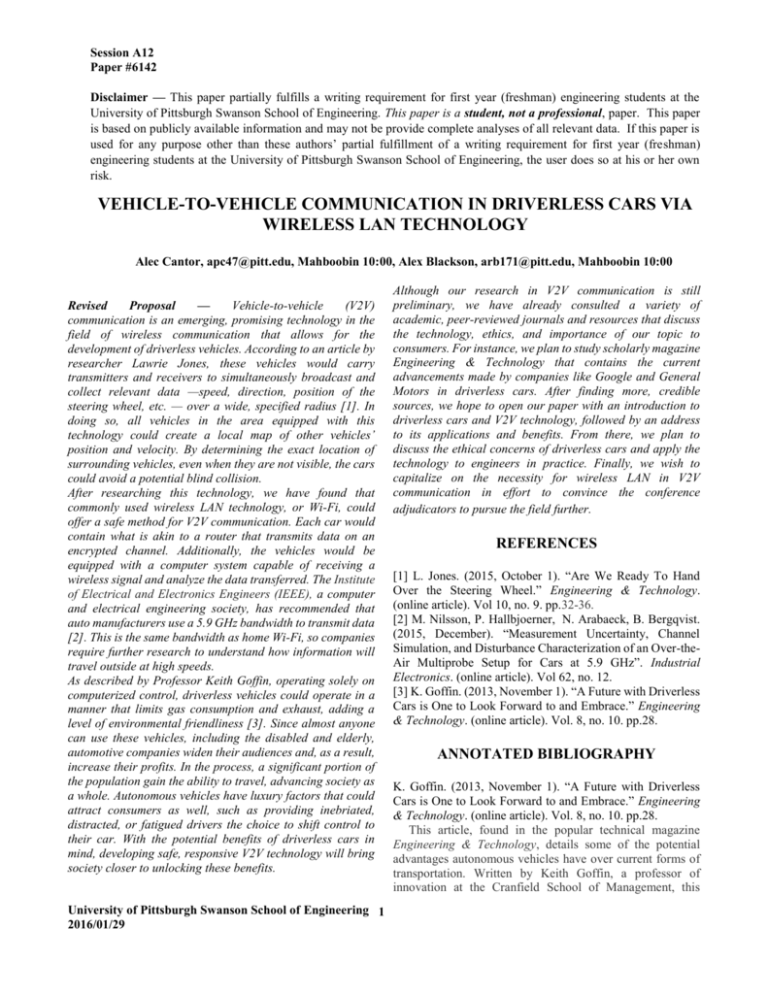
Session A12 Paper #6142 Disclaimer — This paper partially fulfills a writing requirement for first year (freshman) engineering students at the University of Pittsburgh Swanson School of Engineering. This paper is a student, not a professional, paper. This paper is based on publicly available information and may not be provide complete analyses of all relevant data. If this paper is used for any purpose other than these authors’ partial fulfillment of a writing requirement for first year (freshman) engineering students at the University of Pittsburgh Swanson School of Engineering, the user does so at his or her own risk. VEHICLE-TO-VEHICLE COMMUNICATION IN DRIVERLESS CARS VIA WIRELESS LAN TECHNOLOGY Alec Cantor, apc47@pitt.edu, Mahboobin 10:00, Alex Blackson, arb171@pitt.edu, Mahboobin 10:00 Revised Proposal — Vehicle-to-vehicle (V2V) communication is an emerging, promising technology in the field of wireless communication that allows for the development of driverless vehicles. According to an article by researcher Lawrie Jones, these vehicles would carry transmitters and receivers to simultaneously broadcast and collect relevant data —speed, direction, position of the steering wheel, etc. — over a wide, specified radius [1]. In doing so, all vehicles in the area equipped with this technology could create a local map of other vehicles’ position and velocity. By determining the exact location of surrounding vehicles, even when they are not visible, the cars could avoid a potential blind collision. After researching this technology, we have found that commonly used wireless LAN technology, or Wi-Fi, could offer a safe method for V2V communication. Each car would contain what is akin to a router that transmits data on an encrypted channel. Additionally, the vehicles would be equipped with a computer system capable of receiving a wireless signal and analyze the data transferred. The Institute of Electrical and Electronics Engineers (IEEE), a computer and electrical engineering society, has recommended that auto manufacturers use a 5.9 GHz bandwidth to transmit data [2]. This is the same bandwidth as home Wi-Fi, so companies require further research to understand how information will travel outside at high speeds. As described by Professor Keith Goffin, operating solely on computerized control, driverless vehicles could operate in a manner that limits gas consumption and exhaust, adding a level of environmental friendliness [3]. Since almost anyone can use these vehicles, including the disabled and elderly, automotive companies widen their audiences and, as a result, increase their profits. In the process, a significant portion of the population gain the ability to travel, advancing society as a whole. Autonomous vehicles have luxury factors that could attract consumers as well, such as providing inebriated, distracted, or fatigued drivers the choice to shift control to their car. With the potential benefits of driverless cars in mind, developing safe, responsive V2V technology will bring society closer to unlocking these benefits. University of Pittsburgh Swanson School of Engineering 1 2016/01/29 Although our research in V2V communication is still preliminary, we have already consulted a variety of academic, peer-reviewed journals and resources that discuss the technology, ethics, and importance of our topic to consumers. For instance, we plan to study scholarly magazine Engineering & Technology that contains the current advancements made by companies like Google and General Motors in driverless cars. After finding more, credible sources, we hope to open our paper with an introduction to driverless cars and V2V technology, followed by an address to its applications and benefits. From there, we plan to discuss the ethical concerns of driverless cars and apply the technology to engineers in practice. Finally, we wish to capitalize on the necessity for wireless LAN in V2V communication in effort to convince the conference adjudicators to pursue the field further. REFERENCES [1] L. Jones. (2015, October 1). “Are We Ready To Hand Over the Steering Wheel.” Engineering & Technology. (online article). Vol 10, no. 9. pp.32-36. [2] M. Nilsson, P. Hallbjoerner, N. Arabaeck, B. Bergqvist. (2015, December). “Measurement Uncertainty, Channel Simulation, and Disturbance Characterization of an Over-theAir Multiprobe Setup for Cars at 5.9 GHz”. Industrial Electronics. (online article). Vol 62, no. 12. [3] K. Goffin. (2013, November 1). “A Future with Driverless Cars is One to Look Forward to and Embrace.” Engineering & Technology. (online article). Vol. 8, no. 10. pp.28. ANNOTATED BIBLIOGRAPHY K. Goffin. (2013, November 1). “A Future with Driverless Cars is One to Look Forward to and Embrace.” Engineering & Technology. (online article). Vol. 8, no. 10. pp.28. This article, found in the popular technical magazine Engineering & Technology, details some of the potential advantages autonomous vehicles have over current forms of transportation. Written by Keith Goffin, a professor of innovation at the Cranfield School of Management, this Alec Cantor Alex Blackson article supports the innovative technology by describing its practical and environmental benefits and applying them to the current world state. In our paper, this will allow us to argue for the development of a safe form of V2V communication to help realize these benefits. hit a wall or the bystander. While writing from an unbiased standpoint, he raises interesting points that will be the cause of debate in the future of the technology. We will use this article to discuss the ethical decisions in driverless cars. M. Nilsson, P. Hallbjoerner, N. Arabaeck, B. Bergqvist. (2015, December). “Measurement Uncertainty, Channel Simulation, and Disturbance Characterization of an Over-theAir Multiprobe Setup for Cars at 5.9 GHz”. Industrial Electronics. (online article). Vol 62, no. 12. This is a technical article from a magazine called Industrial Electronics from IEEE. The authors explore the specifics of how the V2V technology works. They delve into the bandwidth the cars use to broadcast. In addition, they discuss how such signals would be affected when a vehicle is moving at high speeds. We are going to use this article to further our reader's understanding of how V2V technology works. L. Jones. (2015, October 1). “Are We Ready To Hand Over the Steering Wheel.” Engineering & Technology. (online article). Vol 10, no. 9. pp.32-36. This article is from Engineering & Technology magazine and it addresses some of the concerns in attempting to implement driverless cars into society. The author, Lawrie Jones, discusses from a fairly neutral standpoint how current laws in the UK and most of the world make it difficult to test automated cars, which in turns makes them even more difficult to be safe for consumer use. He also discusses the impact driverless cars will have on society, as a whole. We can use this article to address some of the ethical and legal concerns that driverless cars bring. J. Sanguesa, J. Barrachina, M. Fogue. (2015, December 15). “Sensing Traffic Density Combining V2V and V2I Wireless Communications.” US National Library of Medicine National Institutes of Health. (online article). This article is technical article about the applications of V2V technology. The authors write, from a non-biased perspective, about applying V2V technology to make the roads safer by predicting traffic densities. They also introduce V2I, which is vehicle to infrastructure communication. This will help build a better map of a densely populated area, making them safer to drive in. We will use this article to discuss the technical aspects and applications of V2V communications. K. Kirkpatrick. (2015, August 1). “The Moral Challenges of Driverless Cars.” Communications of the Association of Computing Machinery. (online article). Vol. 58, no. 8. pp. 1920. Published by the Association of Computing Machinery, this article addresses some of the ethical concerns of driverless cars. Taking a neutral approach to the idea, author Keith Kirkpatrick emphasizes the multitude of complications autonomous vehicles must overcome to reach the road. Later in the article, he concedes to the advanced implementation of automation in cars already in practice. We can use this article to further support why continued progress in the field is necessary. M. Smith. (2014, September 12). “How Cars Will One Day Talk to Each Other.” MakeUseOf. (online article). http://www.makeuseof.com/tag/cars-will-one-day-talk/ This article published on MakeUseOf, a website where experts discuss latest technological advances, outlines the communication systems of autonomous vehicles. In which, the author tells of how V2V developments could create a network of cars constantly transmitting data to build a safe, effective transportation system. Citing current manufacturers and the history of the technology, the author offers his support for the use of wireless LAN in cars, which we can integrate into our technical description of our topic. V. Milanés, E. Onieva, J. Pérez, J. Gordy, J. Villagrá. (2011, October). “An Approach to Driverless Vehicles in Highways.” 2011 14th International IEEE Conference on Intelligent Transportation Systems. (conference article). This article presented at an IEEE Conference in 2011 discusses the technical aspects required for autonomous cars to be a safe travel method. While also addressing the physics of the cars, the authors of this proposal identify how V2V communication can potentially make a map of surroundings and adjust the mechanics to adapt to the environment. In our conference paper, we plan to reference this source to lay out the inner-workings of the V2V communications we hope to promote. SOURCES CONSULTED D. Newcomb. (2014, October 1). “Who Should Be the SelfDriving Car’s Moral Compass?” PC Magazine. (online article). In this article, the author, Doug Newcomb, provides insight into the ethical dilemmas that arise when driving a car. He discuss whether or not cars should be programmed to save the driver or a pedestrian in a case where the driver must either “How to Pick a Topic.” University of Pittsburgh University Library System. (2014). (video). TOPIC AREA: COMPUTER ENGINEERING 2 Alec Cantor Alex Blackson For this topic, we hope to apply how wireless LAN signals to the up-and-coming technology of autonomous vehicles. As such, we are not focusing on the mobile functions of the vehicles, but rather, how the signals work to increase the reliability and functionality of the car. For that reason, we believe that our paper best fits into the category of computer engineering. Using the V2V communication, the vehicles use computing systems to send, receive, and interpret the data between vehicles. 3

